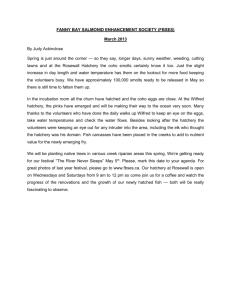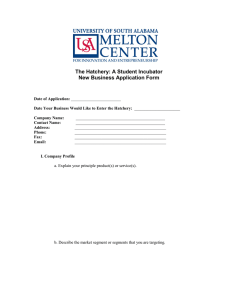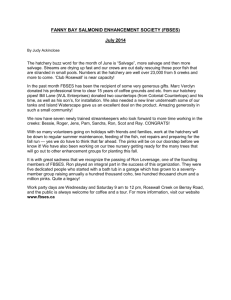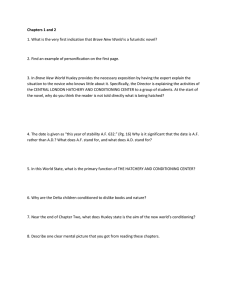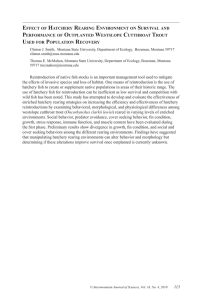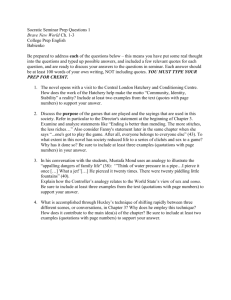POULTRY MANAGEMENT Manage hatchery operations
advertisement
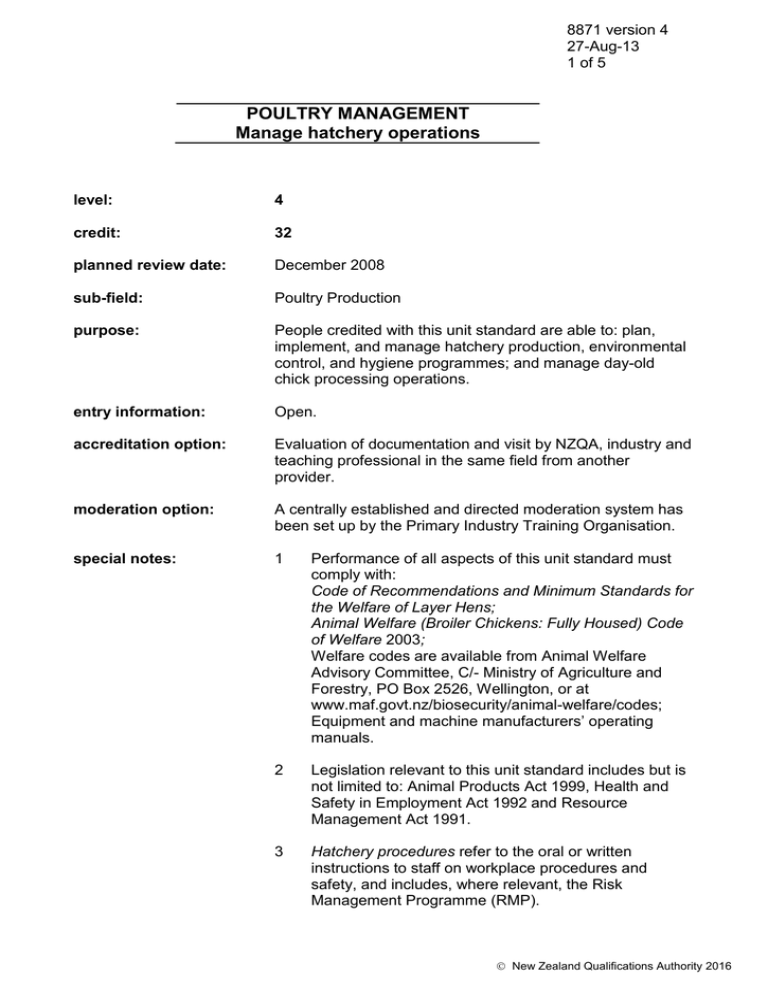
8871 version 4 27-Aug-13 1 of 5 POULTRY MANAGEMENT Manage hatchery operations level: 4 credit: 32 planned review date: December 2008 sub-field: Poultry Production purpose: People credited with this unit standard are able to: plan, implement, and manage hatchery production, environmental control, and hygiene programmes; and manage day-old chick processing operations. entry information: Open. accreditation option: Evaluation of documentation and visit by NZQA, industry and teaching professional in the same field from another provider. moderation option: A centrally established and directed moderation system has been set up by the Primary Industry Training Organisation. special notes: 1 Performance of all aspects of this unit standard must comply with: Code of Recommendations and Minimum Standards for the Welfare of Layer Hens; Animal Welfare (Broiler Chickens: Fully Housed) Code of Welfare 2003; Welfare codes are available from Animal Welfare Advisory Committee, C/- Ministry of Agriculture and Forestry, PO Box 2526, Wellington, or at www.maf.govt.nz/biosecurity/animal-welfare/codes; Equipment and machine manufacturers’ operating manuals. 2 Legislation relevant to this unit standard includes but is not limited to: Animal Products Act 1999, Health and Safety in Employment Act 1992 and Resource Management Act 1991. 3 Hatchery procedures refer to the oral or written instructions to staff on workplace procedures and safety, and includes, where relevant, the Risk Management Programme (RMP). New Zealand Qualifications Authority 2016 8871 version 4 27-Aug-13 2 of 5 POULTRY MANAGEMENT Manage hatchery operations Elements and Performance Criteria element 1 Plan, implement, and manage hatchery production. performance criteria 1.1 Production targets are established for the hatchery unit in relation to fertility, egg size and weight, hatchability, hatching percentage, chick survival, and chick quality. 1.2 Production plan is prepared consistent with the production targets. Range: production plan may include but is not limited to – schedules for timing of purchases, use of production inputs, services required for production, hatchery facilities turn round, production cycle requirements, calendar of operations for each production cycle. 1.3 Production plan is implemented and monitored, problems are identified, and remedial action is taken to optimise performance, in accordance with hatchery procedures. 1.4 The use of hatchery facilities is optimised in terms of length of production cycle and achieving the production targets. 1.5 Selection of eggs for incubating, and timing of egg transfer between hatchery facilities, optimises hatchability, hatching percentages, chick survival, and chick quality. 1.6 Production information is analysed, problems, adverse trends, and causes of below target performance are identified, and remedial action is taken to optimise performance, in accordance with hatchery procedures. 1.7 Staff work routines are planned and implemented to make effective use of staff resources and optimise hatchery productivity. Range: staff work routines may include but are not limited to – daily and weekly work requirements, task priority list, timing of work routines, order of operations. New Zealand Qualifications Authority 2016 8871 version 4 27-Aug-13 3 of 5 POULTRY MANAGEMENT Manage hatchery operations element 2 Plan, implement, and manage environmental control programmes for the hatchery. Range: temperature, ventilation, relative humidity. performance criteria 2.1 Environmental control programme is planned and implemented which meets storage, incubation, and chick processing requirements in relation to hatchability and chick quality. 2.2 Environmental control systems are monitored, problems are identified, and adjustments are made to achieve target performance, in accordance with the planned environmental control programme. 2.3 An emergency procedures plan is developed in accordance with the environmental control programme, and emergency procedures are implemented in the event of environmental control systems breakdown. element 3 Plan, implement, and manage hatchery hygiene programmes. Range: may include but not limited to – vermin control, egg hygiene, facility hygiene, health status sampling, biosecurity, hatchery waste disposal. performance criteria 3.1 Hygiene programmes are planned and implemented with an emphasis on preventative measures in accordance with veterinary recommendations. 3.2 Hygiene programmes are monitored for effectiveness, problems are identified, and remedial action is taken to optimise hatchery performance, in accordance with veterinary recommendations. 3.3 Contingency plans are developed, and carried out in the event of hygiene breakdown or disease introduction in accordance with veterinary recommendations. element 4 New Zealand Qualifications Authority 2016 8871 version 4 27-Aug-13 4 of 5 POULTRY MANAGEMENT Manage hatchery operations Manage day-old chick processing operations. performance criteria 4.1 Chick take off is timed to optimise hatching percentage and chick survival and meets predetermined targets. 4.2 Chick operations, sexing, and vaccinations are supervised and comply with customer requirements, vaccine manufacturer’s specifications, hatchery procedures, and the relevant Animal Welfare codes. Range: 4.3 may include but is not limited to – beak trimming, toe trimming, despurring. Chick processing is supervised, and meets customer requirements in terms of numbers, sex, quality, and weight. Range: may include but is not limited to – grading, counting, weighing, packing, transporting. Comments on this unit standard Please contact the Primary Industry Training Organisation standards@primaryito.ac.nz if you wish to suggest changes to the content of this unit standard. Please Note Providers must be accredited by the Qualifications Authority or a delegated interinstitutional body before they can register credits from assessment against unit standards or deliver courses of study leading to that assessment. Industry Training Organisations must be accredited by the Qualifications Authority before they can register credits from assessment against unit standards. Accredited providers and Industry Training Organisations assessing against unit standards must engage with the moderation system that applies to those standards. New Zealand Qualifications Authority 2016 8871 version 4 27-Aug-13 5 of 5 POULTRY MANAGEMENT Manage hatchery operations Accreditation requirements and an outline of the moderation system that applies to this standard are outlined in the Accreditation and Moderation Action Plan (AMAP). The AMAP also includes useful information about special requirements for providers wishing to develop education and training programmes, such as minimum qualifications for tutors and assessors, and special resource requirements. This unit standard is covered by AMAP 0052 which can be accessed at http://www.nzqa.govt.nz/site/framework/search.html. New Zealand Qualifications Authority 2016
